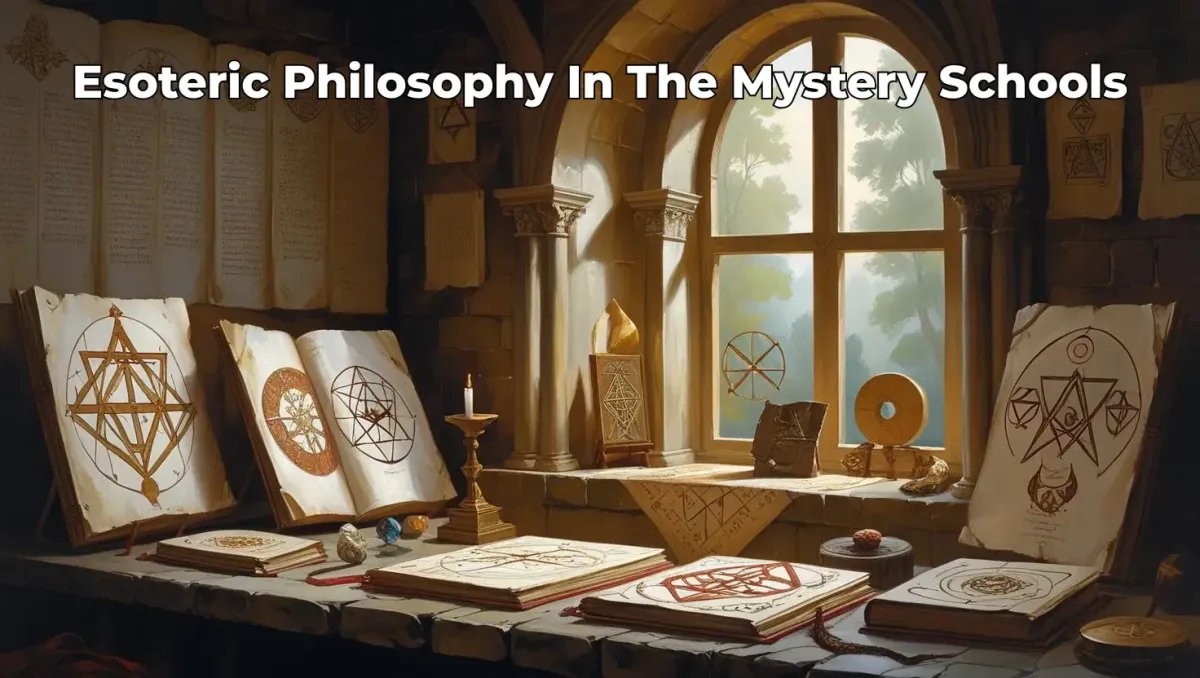
Esoteric Philosophy & Magic: The Secret Teachings of Mystery Schools
Behind the veils of the mystery schools lay a blend of profound philosophy and carefully guarded magical practices. Together, they formed the backbone of the initiatory path — combining wisdom that illuminated the mind with rituals that transformed the soul.
While today the word “magic” often conjures images of superstition or illusion, for the mystery schools it meant something very different. Magic was the art of aligning with divine forces through ritual, symbol, and intention. And philosophy was the framework that explained why such practices worked.
In this article, we’ll journey into the esoteric philosophies and ceremonial magic that powered the initiatory experiences of the ancient mystery traditions.
New to mystery schools? Start with our overview article “What Are Mystery Schools?” and then visit the Mystery School hub for classes, courses and next steps.

The Philosophical Foundations
Every mystery school rested on a philosophical worldview that shaped its practices:
Hermeticism: The teachings of Hermes Trismegistus emphasised unity, correspondence, vibration, and the interplay of opposites (The Hermetic Principles: Universal Laws of the Mystery Schools).
Platonism and Neoplatonism: The world was seen as a reflection of higher forms, with theurgy (divine work) as the means of ascent.
Kabbalah: The Tree of Life mapped the emanations of divine being into creation (Kabbalah and Hermetic Qabalah: The Tree of Life).
Eastern influences: Concepts like prana or Qi, and the idea of transcending illusion (Maya), resonated with the mystery schools’ metaphysics.
Philosophy gave initiates the intellectual map of reality. Magic gave them the experiential key to enter it.
For more on these deep questions, see Metaphysics & Ontology: Mystery Schools and the Nature of Reality.
What people meant by "esoteric philosophy" (plain English)
In everyday use, “esoteric philosophy” means wisdom that works from the inside out. It uses symbols, stories, meditation, ritual and moral practice to transform the person. In academic use, “western esotericism” is a study category that groups currents such as Hermetism, Neoplatonism, Kabbalah, alchemy, Rosicrucianism, ceremonial magic, Theosophy and the occult revival. Both senses share a theme: inner change over mere belief.
Core themes you will see again and again
Correspondences: microcosm and macrocosm mirror one another.
Living nature: the cosmos is meaningful, layered, and participatory.
Imagination & mediation: images, rites, sacred times and places help us align.
Transmutation: the point is transformation, not trivia.
Concordance & transmission: different streams speak to one another; teachings pass through lineages or schools.
Two lenses — practice vs scholarship
Practice lens: “Esoteric philosophy” as a path of ethics, contemplation and symbol. Useful for personal growth when grounded and kind.
Scholarly lens: “Western esotericism” as a neutral label that maps histories, texts and debates. Helpful for clarity and avoiding myths.
Use both lenses. They keep each other honest.
Currents often grouped under esoteric philosophy
Hermetism • Platonic/Neoplatonic ascent • Jewish Kabbalah and Hermetic Qabalah • Alchemy (lab and symbol) • Christian mysticism in dialogue with the above • Renaissance magic (natural, astral, ceremonial) • Rosicrucian manifestos • Theosophy and later occult movements • New Age synthesis.
This is a family resemblance, not a single creed.
Myths vs reality - Common misconceptions to drop
There is one secret doctrine that explains everything.
Symbols are codes for power over others.
Esotericism is anti-science or anti-religion by default.
“Occult” always means harmful.
Reality: ethical esoteric work aims at agency, compassion and clarity. It should integrate with good sense and care for community.
How we hold "esoteric philosophy" here
We treat these traditions as maps. We emphasise breath, posture, attention, journalling and embodied practice so insight lands in daily life. No grand claims. No pressure. Just steady integration with clear boundaries and consent.
The Role of Magic in the Mysteries
In the mystery schools, magic was not a trick or manipulation of nature. It was a sacred art:
Theurgy: Rituals designed to invoke the presence of the divine, elevating the soul.
Symbolic Ritual: Using sacred objects, chants, and movements to embody cosmic truths.
Energy Work: Channeling life force for healing, blessing, and alignment (Compassion-Based Energy Work: Heart-Centred Alchemy in the Mystery Tradition).
Magic was seen as participation in the divine order. By acting ritually, initiates mirrored the patterns of creation itself.
Ceremonial Tools and Practices
Mystery schools used carefully designed tools and practices to focus intention and align with divine energies:
Sacred Geometry: Ritual spaces were built on geometric proportions to amplify energy (Sacred Geometry: Patterns of the Divine in Mystery School Teachings).
Astrological Timing: Ceremonies were aligned with planetary movements to harmonise with cosmic rhythms (Astrology, the Stars, and the Mystery Schools).
Symbols and Sigils: Geometric figures, words of power, and divine names encoded higher forces into visible form.
Incantations and Chants: Sound was used to raise vibration, echoing the Hermetic Principle of Vibration.
Meditation and Trance: Rituals began with deep inner stillness, preparing initiates for vision (Esoteric Meditation: Initiatory Practices for Inner Vision).
Every element of a ceremony carried symbolic weight, teaching initiates through both mind and experience.
Philosophy Meets Experience
Esoteric philosophy and magic were never separate in the mystery schools — they reinforced one another.
Philosophy explained why rituals mattered: they mirrored divine laws.
Magic gave philosophy life: it transformed abstract principles into living experiences.
For example:
The Principle of Correspondence (“as above, so below”) became tangible through sacred geometry in ritual chambers.
The Principle of Vibration came alive through chanting and sound.
The Principle of Polarity was embodied in rituals of balance — light and dark, masculine and feminine.
For more on these universal laws, revisit The Hermetic Principles: Universal Laws of the Mystery Schools.
The Risks and Discipline of Magic
Mystery schools taught that magic was powerful — and therefore dangerous. Without discipline, it could be misused. Reflective psychology and ethical training were essential safeguards (Reflective Psychology and Psychism: The Inner Work of Illumination).
The dangers included:
Ego inflation: Using rituals for personal power rather than service.
Illusion: Mistaking visions for truth.
Distortion: Misaligned intent leading to harmful outcomes.
This is why magic was never taught casually. Only those who had undergone purification, meditation, and heart training were admitted to its practices.
Famous Figures of Esoteric Philosophy and Magic
Throughout history, many great minds were shaped by these teachings:
Pythagoras saw numbers and harmony as divine powers (Pythagoras and the Mystery Schools: Numbers, Music, and Harmony).
John Dee sought angelic communication through ritual magic in Renaissance England (John Dee and the Hidden Knowledge of the Renaissance Mystery Schools).
Isaac Newton studied alchemy and Hermetic philosophy alongside his scientific breakthroughs (Sir Isaac Newton, Alchemy, and the Hermetic Tradition).
Leonardo da Vinci encoded esoteric symbolism in his art, blending philosophy and geometry (Leonardo da Vinci and the Secret Codes of the Mystery Schools).
Each of these figures shows how philosophy and magic were not fringe but integral to human creativity and discovery.
Why Esoteric Philosophy and Magic Still Matter
In today’s rational, materialist world, it can be easy to dismiss philosophy as abstract and magic as fantasy. Yet the mystery schools reveal that both are paths to truth.
Philosophy deepens our understanding of reality.
Magic allows us to experience that reality in transformative ways.
Together, they help us live consciously, harmoniously, and creatively.
Far from superstition, these practices remind us that we are co-creators in a living cosmos.
For the larger framework of these traditions, see What Are Mystery Schools? The Hidden Lineage of Ancient Wisdom.
Safety & ethics — a quick note
Choose teachers who widen your choice and consent. Look for transparent pricing, clear refunds, realistic outcomes, and aftercare. Avoid secrecy-for-payment, miracle marketing, or urgency tactics. If your body says “not for me,” pause and seek another view.
Next Steps On Your Mystery School Path
If this checklist has brought some clarity, take a moment to notice how you feel. Relieved? Sad? Angry that you weren’t given these tools sooner? All of that is welcome.
When you’re ready, you can:
Use this checklist to review any school you’re considering – or already part of.
Visit the Mystery School hub and notice how your head, heart and body respond as you read.
Take a gentle next step with 7 Hermetic Principles (Course) if you’d like to experience Mystery School teaching in a container that values consent, pacing and nervous-system care.
Above all, remember: you are allowed to choose spaces that feel safe enough for your whole being – not just impressive enough for your mind.

The mystery schools remind us that wisdom and experience must walk hand in hand. By uniting philosophy and magic, they created initiates who were not only thinkers but transformers of reality.
At the Bright Beings Academy Mystery School, you can explore esoteric philosophy and magical practice alongside teachings on Hermetic Principles, Alchemy, Meditation, and Sacred Geometry.

FAQs on Esoteric Philosophy and Magic in the Mystery Schools
What is esoteric philosophy?
It is the study of hidden wisdom traditions, exploring the metaphysical principles that underlie reality.
What did the mystery schools mean by magic?
Magic was the sacred art of aligning with divine forces through ritual, symbol, and intention — not illusion or superstition.
Why were philosophy and magic combined?
Philosophy gave the intellectual map of reality, while magic provided the experiential path to live it.
Can these practices be used today?
Yes. Meditation, ritual, sacred geometry, and energy work are modern forms of esoteric philosophy and magic.
Is “esoteric philosophy” one tradition?
No. It’s a cluster of currents and methods that share family traits.
How is it different from “occult”?
“Occult” means hidden. Some streams overlap, but our focus is ethical inner work, not spectacle or control.
What’s the link to mystery schools?
Mystery schools are initiatory or practice-centred spaces. Esoteric philosophy is the worldview and toolkit many schools draw on.
Do I have to accept the cosmology literally?
No. Treat symbols as practice lenses that help you act with more care and coherence.
Where do I start if I’m new?
Begin with foundations: simple breathwork, posture, attention, reflective writing, and short readings. Add complexity slowly.
How do I vet a teacher or school?
Check transparency, boundaries, realistic claims and aftercare. Step back from pressure or secrecy-for-payment.
Further reading
Neoplatonism and Theurgy: The Simple Map Behind Western Mysticism
The Emerald Tablet and As Above, So Below: A Plain-English Explainer
Alchemy Stages: Nigredo to Rubedo — The Inner Transformation Map
How to Vet a Mystery School: Ethics, Fees, Promises & Red Flags
I look forward to connecting with you in my next post.
Until then, be well and keep shining.
Peter. :)
